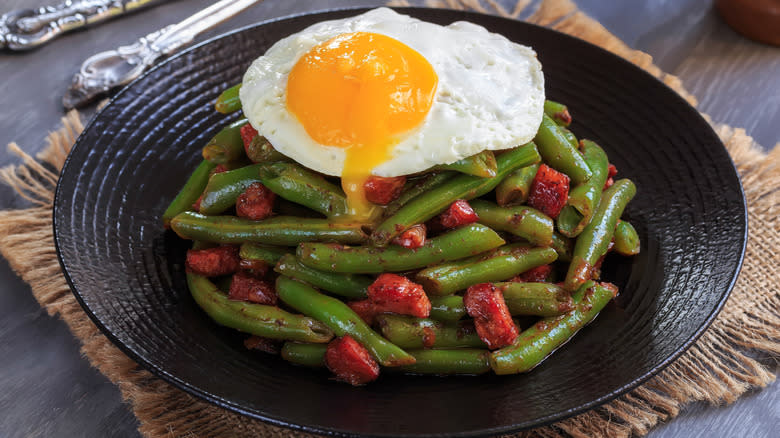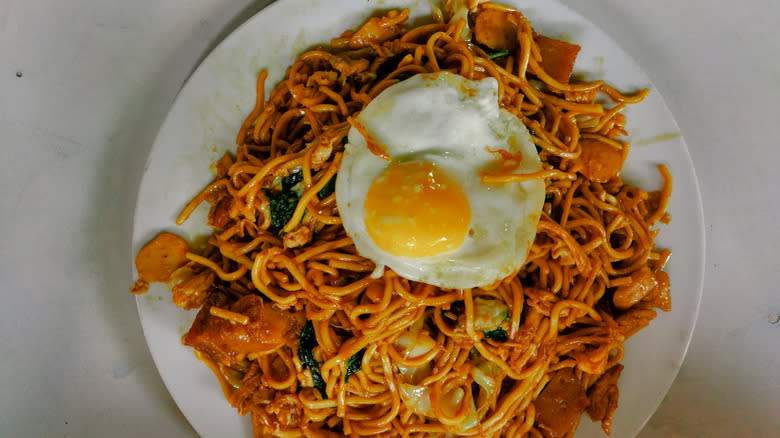A Runny Fried Egg Makes The Perfect Creamy Sauce For Your Stir-Fry

Stir-fry dishes are a classic, everything-but-the-kitchen-sink meal that can satisfy just about anyone's hunger. A blissful combination of protein, veggies, and carbs blasted with savory and sometimes sweet flavors, they're everything we love about food. Among the many reasons to keep stir-fry in your meal rotation, one of the most convincing aspects is that they're customizable. There are a million and one ways to prepare a stir-fried dish, and one of our favorite variations uses a runny fried egg as a sauce.
The runny yolk of an over-easy fried egg imparts a creamy, velvety texture to your favorite stir-fry recipes. And when the viscous yolk mixes with the other ingredients, it gives each bite a rich, luxurious finish. Egg yolks have a subtle yet bountiful flavor that's equal parts savory and buttery, giving your stir fry a unique taste that won't compromise the vibrant flavors of its primary ingredients. Not to mention that fried eggs also add protein to your stir-fry, so if you're not feeling like eating meat, using a fried egg in your recipe doubles as a protein substitute and a one-of-a-kind sauce.
It's not just the stir-fry's flavor and texture that improve with egg yolks, but its golden, milky color and pearly appearance bring an appetizing aesthetic to the dish. Let's get real, who doesn't love watching a creamy egg ooze into their favorite foods?
Read more: 14 Liquids To Add To Scrambled Eggs (And What They Do)
Flavor Integration

Stir-fry can be beefy and hearty or light and low-calorie -- the choice is yours! Whichever way you choose to make your stir-fry, a runny fried egg compliments the full spectrum of ingredients. Egg yolks have a unique ability to absorb and carry the flavors of the other ingredients in dishes, so the creamy yolk helps distribute the stir-fry's various flavors across the entire plate.
Vegetable-forward stir-fries vary in terms of sweetness, bitterness, and earthiness, and the slightly salty flavor of egg yolk can act as a flavor balancer, harmonizing the different taste components in the dish while bringing the vegetable notes together in one swift bite. On the other hand, egg yolks can distribute a strong umami flavor across meatier stir-fries.
Most stir-fries are often prepared with noodles or rice, which are naturally dry and neutral in flavor. Using runny fried egg yolks as a stir-fry sauce gives your dish a more appetizing and decadent texture that won't leave your carbohydrates soggy or greasy, adding flavor and depth to their innately tame palate.
Safety Precautions

Although runny fried eggs and stir-fries go together like peanut butter and jelly, consuming raw or undercooked eggs is never a good idea. If your egg isn't cooked all the way through, your chance of contracting salmonella increases. This ruins your tasty stir-fry and can lead to a slew of unwanted symptoms that can linger for days.
When using runny egg yolks as a saucy ingredient in your stir-fry, knowing when it's safe to eat can be tricky. After all, that irresistible ooze is what it's all about -- but there's a fine line between saucy and salmonella.
Registered Dietician Amanda Holtzer tells Yahoo that you should fry your eggs for at least two minutes before consuming them and also gave her fellow foodies a helpful kitchen suggestion. "When you jiggle the pan, the egg whites should not jiggle, and shouldn't have any jelly-like whites left. The yolk should either not jiggle at all, or, if you like them runny, they should have a slight jiggle."
The most foolproof way to ensure that you're consuming fully cooked eggs is to use a meat thermometer. Fried eggs should be at least 144 degrees Fahrenheit before consumption, so they're good to go once they've reached their ideal temperature.
Read the original article on Daily Meal.

